Conceptual Design in Product Data Mangement: Part 1
The more possibilities for the creation, exploration, and presentation of ideas upfront in mechanical computer aided design the better.
February 1, 2008
By Mike Hudspeth
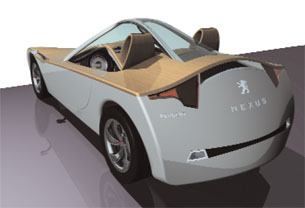 Figure 1: In this concept model from Peugeot, modeled in NX, we see a natural wood finish combined with stylish metal.The model combines both nature and high-tech to produce a concept of what a car could look like. |
Imagination is more important than knowledge. Knowledge is limited. Imagination encircles the world. – Albert Einstein
While there are many stages in a product’s development, the design of that product is arguably one of the most important and earliest aspects. It doesn’t happen all by itself and it’s not always easy. You have to do your homework upfront to ensure a reasonable chance of success. So you begin by assigning the product’s laundry list of requirements, by necessity, into “must have” and “would be nice” categories. Once this is complete, you can launch into one of the most interesting phases of your project: conceptual design.
Conceptual design can mean different things to different people. To some it’s the pie-in-the-sky weird stuff you see at an auto show (see Figure 1, above). These concept vehicles don’t just represent the automotive future, they also represent the style and robustness of the company presenting them. (I personally pay more attention to the concepts that are reasonably close to actual production models than the wild ones. But that’s just me.) To others, conceptual design is all about making prototypes. But while many people would concentrate and thus limit their idea of conceptual design to what they do, it is a wider activity than that.
A good definition of conceptual design is the creation, exploration, and presentation of ideas.
There are many companies that make products to facilitate conceptual design. I talked with a few of them to get their feedback. Bob McNeel, whose company makes the popular software Rhinoceros, defines conceptual design as, “the early part of any design process (which can occur at any point in the product development cycle).”
Paul Brown, director of NX marketing for Siemens PLM Software, makers of NX, says, “Conceptual design or what some call ‘ideation’ defines the general description of the product. During this phase of its lifecycle, many different ideas are explored and evaluated before a final concept design is chosen.”
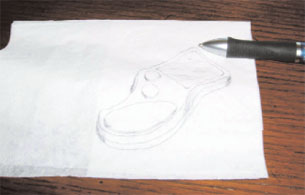 Figure 2: You’d be surprised to find out how many revolutionary devices began with a fast sketch at alocal eatery. Napkin sketches are a wonderful way to visualize a concept. |
“Conceptual design is about possibilities,” says Fielder Hiss, director of product management for SolidWorks Corporation. “Engineering design is about containing those wonderful possibilities within limiters like physics, mathematics, industry standards, manufacturability, and customer requirements.” However it is defined, conceptual design is a vital and indispensable part of any product’s march to reality.
As an industrial designer, conceptual design is my life’s blood. It is different from engineering design. It has always been my opinion that conceptual design is more about what a product might be or do; how it would meet the expectations of the manufacturer and the customer. Engineering design, which is also absolutely important, I define as how to produce the product at a reasonable cost and make it actually function as intended, every time, with the least amount of risk. Conceptual design is about what is possible for a product to be and engineering design is about what a product actually turns out to be. Imagination versus reality.
Conceptual design is focused on presenting the “what if” scenario. Engineering design comes in later and focuses on what it’s going to take to make an idea actually work. You might think one job is superior to the other, but the truth is that each is dependent on the other. As painful and noisy as it may sound, you have to do some brainstorming before you can engineer a product and you have to engineer the details or it won’t work. How is all this done? Let’s take a look at the methodologies behind conceptual design.
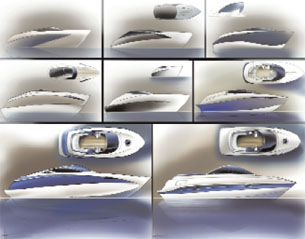 Figure 3: Each sketch explores a different direction the design could possibly go. Sometimes you caneven see a progression from one idea to the next. |
Many Methods
There are many methods to conceptual design. There is the way it’s been done forever and how it is evolving today. The traditional approach begins with sketching. There are many ways you can do this. One of the most stereotypical is napkin sketching. We all know what that is. You’re in a restaurant with a client/customer/colleague talking about the product’s needs. Someone comes up with an interesting approach and you grab a writing utensil and a (hopefully) fresh napkin and within minutes you have a concept (see Figure 2, left). It won’t be perfect but it will be the seed of the product. After you get back to the office you take your napkin and give it to a designer to clean up. They will make pencil drawings to further clarify the design. Once the image depicts what you intended it will be refined further into a marker rendering. That takes someone who is skilled in art. (You cannot underestimate the value of having an artistic person o n your design team.) You will need to make multiple sketches of different ideas; different approaches to your design problems (see Figure 3, page 15). Each idea should explore a new path. You can find yourself generating literally hundreds of ideas. That’s good! It’s called ideation and it’s a way to explore ways of doing things. It sounds like it would be a big time waster, but it’s usually well worth the effort.
The modern approach looks very similar but uses different tools. You can still start with napkin sketches, of course, but instead of going to an artist you can scan your sketch and import it into your design software. Many software programs today allow this. Usually you place the graphic on a plane and then sketch right over it, matching the curves and such as you go (see Figure 4, above). It is a very efficient way to zero in on just the right shape. There are many times when it would take you far too long to guess what the numbers should be. But with a sketch, you can sidestep all that and get it right within minutes.
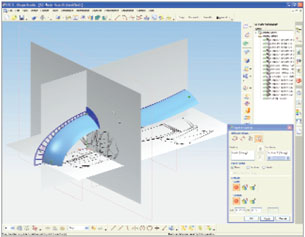 Figure 4: Many software packages now allow you to import a scanned image and essentially trace overit. It is a fast way to get the shape right the first time. |
You can also sketch right on your computer. I love to use the Wacom Cintiq for that (see Figure 5, right). It is an LCD monitor with a pressure sensitive touchscreen built right in. When you use software that supports pressure sensitivity you can change the width of your sketch lines merely by pressing harder on the screen. The Cintiq has an amazingly paper-like texture so it feels like you are using a real sketch pad.
Most modern parametric modelers allow you to create what they call sketches (see Figure 6, page 17). (I know it can be confusing dealing with similar nomenclatures.) Software sketching means you create a profile that you will use to build your models. You create lines and arcs and then apply dimensional and geometric constraints. That way, you can make changes to the sketch and the model will rebuild in a predictable manner. (Always a good thing.) When you make your ideations with a modern 3D computer model you have the freedom to explore different directions with your designs and base them on a common initial model. You model the things that are common to most of the iterations then save the file as a seed file. Then, you can explore different ways of doing things and save them as different file names to keep track of them all. That helps you generate many what-ifs quickly.
“Overall, the software should enable the designer to iterate through as many potential design solutions as possible in the shortest time with the maximum amount of relevant detail,” says Paul Brown. Another really nice advantage to doing things the modern, computerized way is that you can use your 3D model to generate rapid prototyping (RP) models. As nice and informative as some traditional marker sketches can be, there is little that can compare to turning something over in your hands.
What kinds of tools do you really need for conceptual design? I asked a few of the players in the conceptual design field to weigh in on the subject.
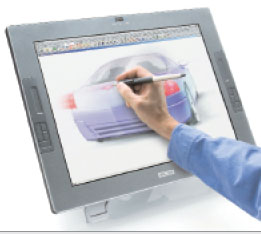 Figure 5: A Wacom Cintiq comes in handy for creating sketches right on your computer. It is the closest thing to apen and paper. |
What is important for conceptual design software?
Bob McNeel: “Ease of exploring (creation and editing) and presenting ideas.”
Paul Brown: “The software should provide advanced visualization capabilities so that the models can then be viewed and refined by surface and solid modeling techniques. The software should then help validate surface aesthetic and curvature properties as well as ergonomic considerations.”
Fielder Hiss: “The more concepts you can explore in the time you have, the better the design will be.”
How important are freeform tools?
Bob McNeel: “Freeform is only important during the conceptual design phase if the final product is freeform. Freeform shapes are seldom used in mechanical devices, but like sheet metal or hydraulic components, freeform shapes need to be at least referenced and positioned by the MCAD tool. It isn’t clear that a standard MCAD product needs to be a robust freeform surface model, any more than it needs to be a robust sheet metal design tool or as an electrical or hydraulic control design tool.”
Paul Brown: “For industrial design, this is very important. … NX allows the industrial and mechanical design to happen within the same set of tools. This allows the overall design process to flow much more naturally than when multiple products are used. This means industrial designers working from scanned data or drawings can work on the same data model with the same tools as their engineering colleagues who are defining the functional aspects of the design.”
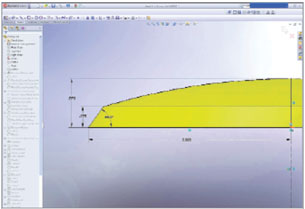 Figure 6: A parametric sketch contains both geometric and dimensional constraints on your geometry.This is a way to exercise strict control over what your models will do. |
Fielder Hiss: “A freeform sketch tool is very important, though the definition of freeform can vary. Our software, for example, provides an intuitive interface and tools for experimenting with shapes and surfaces before getting into the meat of engineering design.”
What are the limitations of the modern methodology?
Bob McNeel: “We do see many of our Asia customers remodeling from 2D drawings in Rhino so they can export the models to their CAM system. The main reason seems to be that they have many customers that are using many different high-end MCAD systems and they cannot afford to purchase all of them. So instead, they just ask for the 2D drawing and then remodel everything in Rhino since it is affordable.”
Paul Brown: “Most systems today can’t quite match the feel of pen and paper. Paint style products capture the artwork but fail to capture the intent. Engineering mathematical-based solutions limit the freedom of the artwork approach.”
Fielder Hiss: “Most MCAD tools fall short when it comes to offering the absolutely freeform, ‘artistic’ experience that you get with pen and paper.”
Next month, we will explore the subject more with comments from our experts on what trends are forming and where they are likely to take us in the future.
More Info
Robert McNeel & Assoc.
Seattle,WA
Siemens PLM Software
Plano, TX
SolidWorks Corp.
Concord,MA
Mike Hudspeth is a senior designer for a global medical company and has been using a wide range of CAD products for more than 20 years. He, his wife, two daughters, and their cats live outside of St. Louis, MO. Send him an e-mail about this article to [email protected].
Subscribe to our FREE magazine, FREE email newsletters or both!






